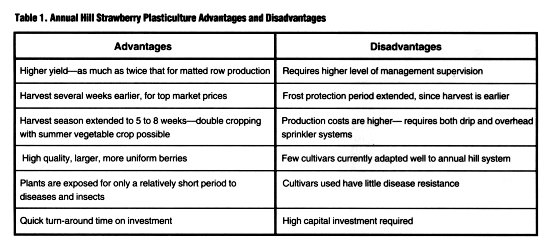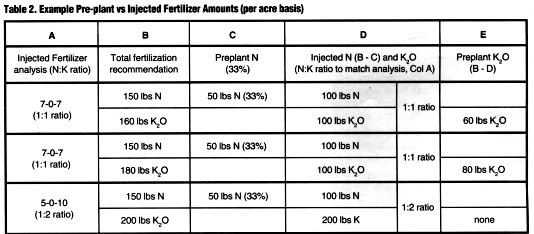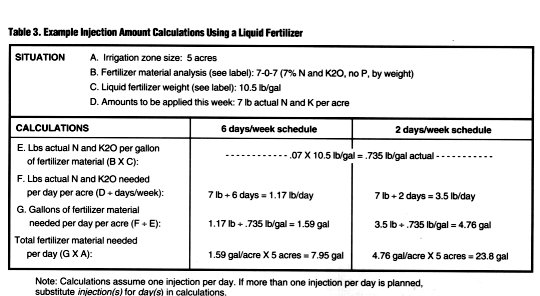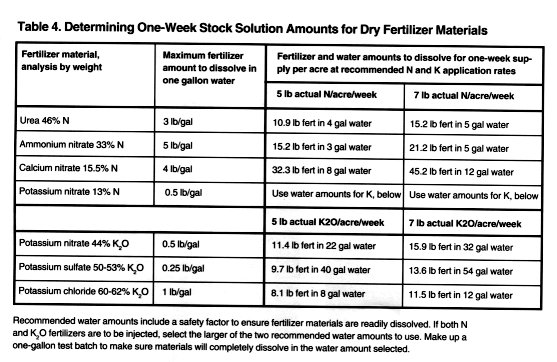
- Home
- Managing An Irrigation System
- Planning System Hardware
- Farm Irrigation Systems & Cost Analysis
- Water Resource Development
- Micro Irrigation Handbook
- Related Links
Commercial Strawberries
David G. Himelrick, Extension Horticulturist
Larry M. Curtis, Extension Agricultural Engineer
Ted W. Tyson, Extension Agricultural Engineer
Irrigation is essential for all commercial strawberry production, whether the traditional matted row or newer annual hill system is used. In matted row production, berries are grown as perennials, with crops being harvested for three to four years. Matted row strawberries are typically grown using only overhead sprinkler irrigation. Annual hill production uses drip irrigation under black plastic mulch, combined with overhead sprinklers for plant establishment and for frost protection.
The annual hill plasticulture approach has become the generally preferred technology for commercial strawberries. While costs are higher for annual hill berries, potential yield and profits are also much higher. Further profits can be realized through double cropping, since the strawberries can be harvested in time to plant a summer-season vegetable crop.
Annual hill strawberries take advantage of the primary strengths of micro-irrigation: enabling consistently high yield and quality of a high-value, high-demand crop while conserving both water and energy. The annual hill production process usually spans about seven months, from fall through the following spring. Raised beds are prepared in the fall and plastic mulch installed, with drip tubing either laid on the soil surface under the plastic mulch, or buried 1-2 inches deep in the bed. Strawberries are planted through slits in the plastic mulch, and overhead irrigation started immediately to ensure plant survival.
After plants are safely established (usually within a few days), irrigation is switched to the drip system. Fertilization is fine-tuned for best production by injecting a portion of the fertilizer needed through the drip system during the growing season. After berries are harvested, plants and plastic are removed, and the process begins again the following fall. Table 1 lists the primary advantages and disadvantages of annual hill plasticulture strawberry production.
This publication explains the use of micro-irrigation in annual hill strawberry production. For more inforination on strawberry production in Alabama, see Circular ANR-633, Commercial Strawberry Production Guide.

Management Requirements
Growing strawberries using the annual hill plastic mulch method requires added attention to detail and increased management supervision in order to produce the highquality, predictable crop required for either pick-your-own (PYO) marketing or shipment to distant markets. Circular ANR-654, Plastic Mulch Culture for Vegetables, explains the basics of the plastic mulch procedure.
Proper bed preparation, including fumigation and laying of the drip tubing and mulch, is critical for success. The system must be chlorinated regularly and closely monitored for proper operation. Fertilizer applications through the system should be made on a frequent, often daily basis. Since rain fall will not replenish soil moisture under the plastic mulch, soil moisture levels must be carefully monitored, using tensiometers, and irrigation scheduled to meet plant water requirements. In the spring, growers must watch weather closely and be prepared to protect against frost damage.
Using the plastic mulch produces a cleaner, easier-to-pick crop and is preferred by PYO customers. PYO marketing, however, carries its own management demands. If berries are to be shipped, harvest labor must be arranged for and provision must be made to rapidly cool berries before shipment.
System Design
Since annual hill strawberries are a spring crop, water requirements and system pumping capacity are not as high as may be needed for a summer crop. A system designed to meet a peak crop water demand of about .2 inches per day, or 5,431 gallons per acre, should be adequate. Note that this is the actual water application amount needed. At typical drip system application efficiencies of 80-85%, the pumping capacity needed to actually deliver this amount would be 6,390 to 6,789 gallons per acre per day. Note: If the system will be used to irrigate a summer- season crop with higher water requirements, needs of this crop will determine the required system pumping capacity.
Drip laterals may be either drip tape or in-line tubing. Drip tape has emitters formed-in as part of the manufacturing process and is a relatively inexpensive product usually used for only one season. In-line tubing has drip emitters factory-installed inside the tubing and usually is made of heavier-gauge material so it can be used for a number of growing seasons. If double-cropping is planned, the drip lateral product should be chosen with the surnmer season crop in mind also. Various emitter or outlet spacings are available. For sandy soils, 8-inch spacing is commonly used. For heavier soils, 12-inch spacing is usually adequate.
The drip lateral flow rate affects overall system flow rate. The following example shows calculations using drip tape with a flow rate of .4 gpm per 100 feet, and with beds spaced on 5-foot centers (87.1 100- foot bed lengths per acre). Assuming 80% efficiency and a peak water requirement of 6,789 gallons per acre per day, the maximum water amount applied per 100 feet each day will be:
6,789 gal/acre/day = 78 gal/100 ft/day
87.1 100-ft bed lengths/acre
Using drip tape with a flow rate of .4 gpm, the flow rate needed will be 34.8 gpm per acre:
87.1 1 00-ft lengths/acre x .4 gpm/100 ft = 34.8 gpm/acre
Keep in mind that this is the design capacity. Actual operating times and amounts applied will vary, depending on scheduling decisions (see Scheduling Irrigation, below).
For maximum efficiency, the field should be divided into several zones to be irrigated in turn, reducing the required system flow rate. For example, if in the above example the field is 8 acres, overall system flow rate for the entire unzoned field would be 278.4 gallons per minute:
8 acres x 34.8 gpm/acre = 278.4 gpm
Dividing the field into 4 zones of 2 acres each reduces system flow rate to 69.6 gallons per minute:
2 acres x 34.8 gpm/acre = 69.6 gpm
The time needed to apply the peak required water amount for each zone in this example will be 3 hours 15 minutes:
78 gal/100 ft +.4 gpm/100 ft = 195 minutes = 3.25 hours
Using four zones, the entire field can be irrigated in 13 hours:
3.25 hr/zone x 4 zones = 13 hours.
Maximum irrigating time for the entire field should not be more than 12-18 hours. Decisions on drip line flow rate and zoning should also take fertilizer injection timing requirements into consideration, as explained below.
For more details on system design decisions and calculations, see Circular ANR-645, System Design.
Bed Preparation and Establishment
Figure 1 shows a recommended bed configuration for annual hill strawberries, with closely spaced plants in a double row on each bed. Careful attention to soil condition and to adjustment of equipment is essential in order to form beds and to place the plastic so that it will stay in place and provide an optimum environment for the strawberry plant root system. Equipment required includes a bed maker, equipment for fumigating the soil, and equipment for laying the plastic mulch and drip tubing.

Figure 1. Typical double-row annual hill bed construction
For successful bed preparation and plant establishment, soil must be moist but not saturated. Beds usually are shaped, pressed, and dry fertilizer incorporated in one operation. Soil fumigation is usually done by injecting a fumigant down into the bed through tubes attached to shanks that are puffed through the bed by a specially equipped tractor. Plastic mulch and drip tubing are then laid in place together in a separate operation. An alternative fumigation method is to inject liquid fumigants through the drip system.
CAUTION: With either fumigation method, planting cannot be done until the fumigant has dissipated. A safe waiting period is typically about two weeks.
Overhead sprinkler irrigation must be started immediately after plants are set to prevent foliage loss. Because the overhead sprinkler system is designed for frost protection, the application rate is usually well over the rate needed for plant establishment. For this reason, a controller can be used to cycle the sprinkler system on and off. A 7-minute on period followed by 8 minutes off is usually adequate, The important point is to make sure plants are kept moist.
Overhead irrigation should be maintained during day fight hours until plants are well established, which usually takes only a few days but may be as much as two weeks, depending on weather and on soil and plant conditions at planting. Irrigation should be switched to the drip system as soon as practical, since overhead irrigation will not provide adequate soil moisture for an extended time.
Scheduling Irrigation
For strawberries grown on plastic mulch, a scheduling procedure that maintains near optimum soil moisture is needed for best crop yield and quality. Soil moisture should be monitored and the system operated on a daily basis as needed. On very sandy soils, the system may even have to be operated more than once per day to maintain the desired soil moisture.
Tensiometers are recommended for monitoring soil moisture. The sensing tips should be placed in the actively growing root zone and located 4 to 6 inches offset from the drip tubing. Irrigation should be scheduled so as to maintain tensiometer readings in the 10 to 20 centibar range, allowing not more than 20% depletion of soil moisture. Close monitoring is needed, especially on sandy soils.
For more information on scheduling considerations and procedures, see Circular ANR-647, Water Management and Scheduling. Also see Drip Tape Operating Requirements in the appendix of the Alabama Micro-Irrigation Handbook for tables showing operating time and gallons of water to apply per zone for various conditions.
Frost Protection
Since annual hill plasticulture strawberries ripen as much as two weeks earlier than matted row strawberries, the overhead sprinkler system is essential for frost protection in the spring. Temperature should be monitored with a reliable, calibrated thermometer placed at plant level in a low spot in the field open to the sky. The critical temperature for strawberries is about 30° F.However, temperature will drop suddenly several degrees when sprinkling is started, and the safest procedure is to begin irrigation when.the temperature reaches 34° F. Irrigation should be continued until the temperature at plant level rises above 32° F and ice is rapidly melting.
The application rate needed will depend on the low temperature expected and on wind conditions. If there is no wind, applying 0. 10 to 0. 13 inches per hour can give protection down to 22 -24° F. If wind rises to 5 mph, however, an application rate of about 0.5 inches per hour will be needed to give the same protection. Windborne freezes are very difficult to protect against. The heat given off by the freezing water is rapidly dissipated by the wind, and the application rate needed to supply adequate water under very cold conditions can be as much as one inch per hour. At wind speeds above 5 mph, more damage may be done by irrigating than by not irrigating.
For more information on frost protection, see Frost and Freeze Protection Using Sprinkler Irrigation in the appendix of the Alabama Micro-Irrigation Handbook.
Fertilization Requirements
Applying fertilizers through the system during the growing season allows for better control of plant nutrition as well as more efficient use of the fertilizer. As with other crops, fertilizer needs should be established through soil testing. Only nitrogen (N) and potassium (K) should be considered for injection. All phosphorus (P) and micronutrients should be incorporated before planting.
A total of about 150 to 170 pounds of nitrogen (actual) is usually needed per acre per season. Typically, about one third of this requirement (50 to 60 pounds of actual N) is incorporated before planting, and the rest of the total N requirement injected during the season. From plant establishment until winter dormancy, plants should receive about 5 pounds N per acre per week. When spring flowering and fruiting begin, plants should receive 7 pounds of N per week. CAUTION: Over-fertilizing with nitrogen can cause losses in both yield and fruit quality.
Typically, about 50% of the potassium requirement is pre-plant incorporated and the rest injected along with the nitrogen. An alternative procedure that has been successful in some research trials is to apply all needed potassium pre-plant, so that only nitrogen is injected during the growing season.
Fertigation Procedures
In applying fertilizers through the system, the following important points must be observed:
- If possible, fertilizer materials to be injected should be commercial liquid-form preparations labeled for irrigation injection. Dissolving dry fertilizer materials for injection is less expensive but is time-consuming and can cause serious problems if not done properly.
- To avoid clogging and salinity problems and to spread fertilizers uniformly, fertigation should be done on a daily basis (6 days a week). If weather, management or labor considerations require less frequent applications, fertigation should be done at least twice a week. Soil water-holding capacity must be checked to be sure soil will accept irrigation amounts applied. Fertilizers should be injected over a period of at least 60 minutes.
- Soil moisture in beds must be monitored. During cloudy or cool weather, crop water use may be low and the soil may be near field moisture capacity. If the soil cannot hold-the irrigation amounts applied, part of the irrigation water carrying the fertilizer will be lost to runoff or to percolation below the root zone. In this case, fertigation schedules must be adapted to the irrigation need.
If both N and K are to be injected during the growing season and a single fertilizer preparation is used, the fertilizer material analysis will determine amounts of K to be pre-plant incorporated vs injected. Table 2 shows examples of how to divide pre-plant vs injected amounts according to the fertilizer analysis and total fertilization recommendation. For example, a 7-0-7 liquid fertilizer material contains 7% of both nitrogen and potassium. Therefore, enough K should be pre-plant incorporated so that the amount to be injected is equal to the amount of N to be injected. The key is that he proportions of N and K injected must match the fertilizer analysis.
CAUTION: Using fertilizers with ammonium N in fumigated soils can result in ammonium toxicity to the crop. At least half of the nitrogen fertilizer applied should be in the nitrate (NO3) form.
For more information on procedures and precautions to be observed in using both liquid and dry fertilizer materials, see Circular ANR-653, Applying Fertilzers Though the System. For information on soil moisture monitoring, see Circular ANR-647, Water Management and Scheduling.

Using Liquid-Form Fertilizers
Available liquid fertilizers include various formulations including either nitrogen only, or nitrogen plus potassium. Table 3 shows how to calculate daily injection amounts, using a typical N + K liquid fertilizer:
The example shows that to satisfy the week's N and K requirement for the 5-acre zone using a six-day schedule with one injection per day, 7.95 gallons of fertilizer material will be needed per day (per injection). Using a two-day schedule (one injection per day) will require 23.8 gallons of the 7-0-7 fertilizer material each day.
Usually, some amount of water must be added to the liquid fertilizer material in order to extend the injection time to at least 60 minutes. For example, if the injection pump rate is 20 gallons per hour, 20 gallons of fertilizer solution will be needed so for the 6-day schedule 12.05 gallons of water must be added to the 7.95 gallons of prepared liquid fertiltizer in the injection tank (7.95 gal + 12.05 gal = 20 gal).

Using Dry Fertilizers
When dry fertilizers are used, the procedure is similar, except that the fertilizer materials must be dissolved in water. Fertilizer materials must be a soluble high grade and not be coated, in order to completely and cleanly dissolve. several precautions must be kept in mind when using dry fertilizers, as explained below. A grower planning to use dry fertilizers for injection should study ANR-653, Applying Fertilizers Through the System, for details before attempting fertigation with these materials.
To determine the amount of dry fertilizer to be used, divide the needed actual amount by the fertilizer analysis percentage (as a decimal). For example, ammonium nitrate (33-0-0) contains 33% actual N. If 7 pounds actual N per acre are needed for one week's fertigation, the amount of ammonium nitrate needed per acre will be 7 lb ÷ .33 = 21.2 lb. Per day amounts needed (one injection per day) will be:
Two-day schedule:
21.2 lb/week/acre = 10.6 lb/day/acre (of 33-0-0 fertilizer)
2 days/week
Six-day schedule:
21.2 lb/week/acre =3.53 lb/day/acre (of 33-0-0 fertilizer)
6 days/week
To find the total amounts to be applied to the irrigation zone each day, multiply the per acre amount by the number of acres in the zone. For a six-day schedule with five-acre zones, for example, this amount would be:
3.53 lb/acre/day X 5 acres/zone = 17.65 lb/zone/day
For injection into the system, the dry fertilizer is dissolved in enough water to give an injection period of at least 60 minutes. This amount is determined by the injection pump rate. For example, if the injection rate is 30 gph, then 30 gallons of fertilizer solution will be injected in 60 minutes.
CAUTION: Be sure that the amount of water used is sufficient to dissolve the fertilizer materials completely. if dry fertilizers do not dissolve completely or come out of solution in the tank, they will clog the irrigation system.
Table 4 lists recommended maximum fertilizer amounts that can be dissolved per gallon of water for strawberry fertigation. Dry fertilizers do not dissolve as readily in cold water as in warm water. Because strawberry fertigation is done in the cooler months, when available water is likely to be colder and to cool further in injection and storage ranks, the Table 4 recommended amounts include a safety factor above normal solubility ratings for dry fertilizers.
Table 4 also gives recommended fertilizer and water amounts for making up a one-week stock solution. The examples at right show how to use Table 4 for different fertilizer materials and amounts to be applied. In making up batches for injection or for a stock solution, growers should keep the following in mind:
- Some dry fertilizer materials require much more water than others. For example, dissolving potassium nitrate requires almost ten times as much water as does ammonium nitrate.
- If two or more dry fertilizers are combined, test the solubility of the combination in one gallon of water. The procedure is to take measured amounts of the fertilizers in the ratio they will be used. First add and mix the measured amount of the fertilizer with the lowest solubility, then slowly add (while mixing) the other fertilizer(s). Also be aware that unwanted chemical reactions may occur when two different dry fertilizers are dissolved together.
- Injection and storage tanks must be protected from freezing. Injection tanks should include a mechanism for agitating the solution. If storage tanks are used they should be re-stirred and inspected daily.
Examples of how to use Table 4 for making up and using one-week stock solutions: |
| For injecting 7 Ib actual N and K/week/acre,using ammonium nitrate and potassium chloride:
1. Determine amounts for material with lowest solubility, potassium chloride. Read across table to 7lb K column, find 11.5 lb fertilizer to dissolve in 12 gallons water for each acre in irrigation zone. 2. For a 5-acre zone, 5 acres x 11.5 lb = 57.5 lb potassium chloride to dissolve in 60 gallons water (5 acres x 12 gal/acre = 60 gal). 3. Read across ammonium nitrate row to 7 lb N column, find 21.2 lb fert needed per acre, 5 acres x 21.2 lb/acre = 106 lb ammonium nitrate to be added to 60-gallon potassium chloride solution. 4. For a six-day injection schedule, use one-sixth of the 60 gal = 10 gallons of stock solution per injection (assuming one injection per day). For a three-days/ week schedule, inject 20 gallons each day. For twice a week application, inject 30 gallons each day. Add water if needed to extend injection time to 60-90 minutes. |
| For injecting 5 Ib actual N and K/week/acre using potassium nitrate and urea:
1. Determine amounts for the material combining N and K, potassium nitrate, starting with the element with highest analysis, K20. Read across table, find 11.4 lb fertilizer needed for each acre in irrigation zone. This will complete the K20 requirement/acre. 2. Compare recommended water amounts for the two fertilizers, use the highest: potassium nitrate at 22 gallons/acre. 3. Potassium nitrate also adds 13% N: 11.4 lb X.13 1.5 lb actual N, leaving 5 lb - 1.5 lb = 3.5 lb actual N still needed per acre, from urea. Divide amount needed by urea N analysis: 3.5 lb ÷ .46 = 7.6 lb urea (46% N) to add to solution per acre. 4. If Irrigation zone is 6 acres, total amounts needed will be 11.4 lb/acre x 6 acres = 68.4 lb potassium nitrate, and 7.6 lb/acre x 6 acres = 45.6 lb urea, in 132 gallons of water (22 gal/acre x 6 acres = 132 gal). 5. Divide into six-day, three-day, or two-day per week injection schedules. Add water if needed to extend injection time to 60-90 minutes. |

References
Albregts, E.E. and C.M. Howard. 1976. Effect of intermittent irrigation and antitranspirants on establishing strawberry transplants on mulch, Proceedings, Fla. State Hort. Soc. 89:85- 86.
Clark, G.A. 1991. Water management for drip irrigated strawberries, Proceedings, North American Strawberry Growers Association, 1991.
Himelrick, D.G., A.A. Powell and W.A. Dozier. 1992. Commercial Strawberry Production. Circular ANR-633, Alabama Cooperative Extension Service, Auburn University.
Hochmuth, G.J., ed. 1988. Strawberry Production Guide for Florida. Circular 142C, Florida Cooperative Extension Service, University of Florida.
Krewer, G. and S. Myers. 1989. Commercial Strawberry Culture. Bulletin 963, Georgia Cooperative Extension Service, University of Georgia.
Locascio, S.J., J.M. Myers and F.G. Martin. 1977. Frequency and rate of fertilization with trickle irrigation for strawberries, J.Amer. Soc. Hort. Sci. 102(4):456-458.
Perry, K.B. and E.B. Poling. 1985. Field observation of frost injury in strawberry buds and blossoms, Advances in Strawberry Production 5:31-38.
Poling, E. B. 1989. Strawberry Plasticulture. Leaflet 205-E, N.C. Agricultural Extension Service, North Carolina State University.
Publication No.Micro-Irrigation Handbook ANR-662 |
Mar. 1999 |
Larry M. Curtis, Extension Agricultural Engineer, Professor, Biosystems and Agricultural Engineering, David G. Himelrick, Extension Horticulturist, and Ted W. Tyson, Extension Agricultural Engineer, Associate Professor, Biosystems and Agricultural Engineering. |
Issued in furtherance of Cooperative Extension work in agriculture and home economics, Acts of May 8 and June 30, 1914, and other related acts, in cooperation with the U.S. Department of Agriculture. The Alabama Cooperative Extension System (Alabama A&M University and Auburn University) offers educational programs, materials, and equal opportunity employment to all people without regard to race, color, national origin, religion, sex, age, veteran status, or disability.
This document is author-produced (unedited).

 Menu
Menu


